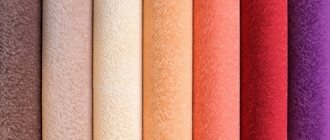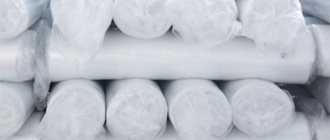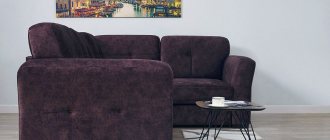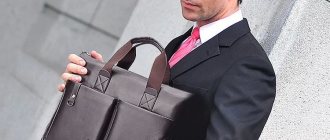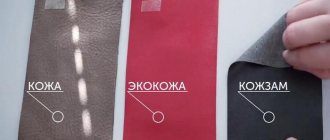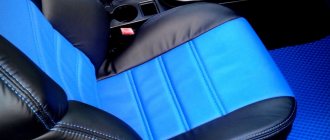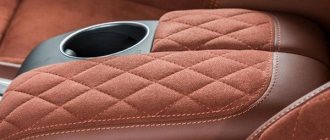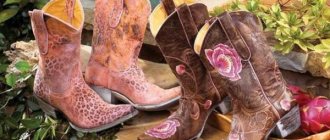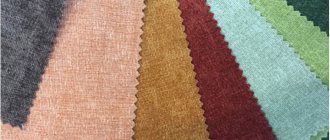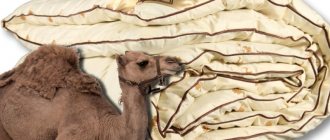It is not difficult to distinguish natural leather from artificial materials in only one case. When you buy a piece of leather in a store. Genuine leather is sold as whole, tanned animal skins, and its size is measured in square decimeters. In all other cases, you can easily buy a leather substitute instead of natural material, since manufacturers of leather clothing often use various kinds of materials that not only look like leather, but also have the basic characteristics of materials of animal origin.
About how to choose leather clothes so as not to buy an obvious fake. What are the differences between genuine leather and artificial leatherette? What is eco-leather, nubuck and what types of real leather are there and their brief characteristics.
In this video you will see how easy it is to sew leather on an industrial sewing machine (or Podolsk type) by installing a Teflon foot on it.
You can buy genuine leather only in specialized stores.
You can buy genuine leather only in specialized departments or fur studios. And as mentioned above, it is sold in whole skins. But the quality of the skin itself also varies and it depends not only on the type of raw materials, but also on the technology of processing the skins (curing) and the quality of the chemicals used for these processes, etc.
If you have ever taken apart leather clothes, then perhaps you have noticed that expensive things look beautiful not only on the outside, but also on the inside. The matte, almost smooth surface has a uniform color, and the leather itself is thin and durable. But we will not delve into these features; we will only say that the skin can be stretched, which makes its size increase, but its strength decreases. But you won’t be able to determine this, but you need to know why leather clothes are sometimes so inexpensive.
As for artificial leather, eco-leather and other leatherettes, they are all sold in rolls. This easily reveals its artificial “origin.”
Types of artificial leather
Depending on the purpose (decorative and household, clothing, furniture, technical), leatherettes of varying degrees of hardness and strength are made:
- by structure –
porous;
- monolithic;
- combined;
- baseless;
- basic;
- reinforced;
- soft artificial and synthetic (have a fibrous structure and contain plasticizers);
The properties of a material largely depend on which polymer is included in its composition. Therefore, the most common classification is by polymer coating.
There are artificial leathers where they are used:
- polyvinyl chloride – vinyl, vinylis (PVC/PVC);
- polyurethane (PU/PU);
- nitrocellulose (NC/NC);
- polyamide (PA/PA);
- polyester (PE/PES/PL);
- rubbers and mixtures.
Production technologies and types of coating determine the physical and chemical properties of the material:
- sustainability
to high and low temperatures,
- deformation, vibration, abrasion,
- chemical exposure,
- ultraviolet;
How to identify skin by external signs
Since our site is aimed at those who are learning to sew with their own hands, the main emphasis is on leather as a material for sewing. But at the same time, these tips can also be used when purchasing ready-made clothes made from genuine leather.
First of all, genuine leather differs from artificial materials in its reverse side. It is called bakhtarma and is a loose fibrous surface. Bakhtarma resembles pile, sometimes similar to velvet, hence its name. It is important that the color and skins be the same on the front and back. This is exactly how leather skins are dyed, in one container. This rule applies to patent leather and any other leather with a decorative coating on the front side - on the back side there will still be fluff, no glued to the fabric, no smooth surface, otherwise it is not genuine leather. But it should be taken into account that manufacturers of artificial leather have long learned to fake the external signs of leather and cannot be guided only by them.
Another indirect difference can be considered the size of the skin. Since both the size itself and the defects found on the skin (holes, tears, thickenings, etc.) do not allow cutting out large parts, the presence of numerous seams on leather clothing is another sign. But again, conditional.
Any leather has a specific smell that will last for many years. This can also be considered a difference that helps identify natural leather, but not always. Reducing the cost of goods forces manufacturers to imitate even the smell of natural leather using special chemicals.
Well, mentioning that every leather item should have a label made of a piece of natural material in the shape of a stretched animal skin is only possible for general erudition. A diamond design means a synthetic material, a matting design means textiles.
Fabrics
The fabric is widely used for upholstery. There are a huge number of varieties of textiles. They differ in color, texture, materials used, etc.
With the right choice of color and pattern, you can achieve excellent results. This is an imitation of other surfaces, as well as simply unusual and original surfaces.
The tissue under the skin can be:
- natural;
- artificial;
- combined.
Most choose the natural option. Artificial fabric is perceived with caution. Although this is misleading.
Yes, natural textiles are safe, environmentally friendly, as well as hygienic and breathable. But it is rarely used in its pure form. Even natural raw materials are bleached, dyed and subjected to other processing methods.
Artificial and combined fabrics are a universal option. In my opinion, upholstery and upholstery are better made from combined raw materials. It combines the advantages of natural and synthetic fibers.
There is even a special type of textile material. This is lacquer. Real leather-like fabric. It is an artificial product. Externally it looks like patent leather. It would be a good choice for a loft-style sofa, by the way.
Advantages and disadvantages
When thinking about what is better - leather-like fabric or eco-leather for furniture, it is worth comparing their strengths and weaknesses.
High-quality fabric will be matched, as will leather. Unfortunately, many sofas are made from mediocre materials. And in both cases the result is disappointing.
Sofas made from fabrics receive the following advantages:
- pleasant tactile sensations;
- the bed and the person do not slip on the surface;
- good breathability;
- comfortable sleep;
- temperature preservation regardless of the time of year;
- resistance to mechanical damage, which is superior to eco-leather;
- affordable price per 1 meter;
- easy care at home without dry cleaners or specialists;
- cozy atmosphere created in the house.
The textile upholstery of the sofa, made with original prints, also has its disadvantages.
The disadvantages are the following:
- Dust accumulation
. Textiles can be considered a dust collector. Needs to be cleaned regularly. Preferably a vacuum cleaner with good traction; - Static charge
. A characteristic feature of furniture made from artificial fabrics; - Life time
. Some sofas wear out within 5 years. But there are also those that serve for 10-20 years; - Care
. This applies to some materials. Especially expensive ones. It is better to go to dry cleaning for care.
Everything is relative. And it depends on the specific material. Still, textiles are a general concept.
By the way, I have already talked separately about the choice of fabrics for the sofa.
Other signs of natural material (leather)
So, in order to be able to identify genuine leather and be able to distinguish clothes made from artificial leather, remember these basic rules. But do not forget that you cannot rely on them 100%. Modern technologies for the production of fabrics and materials are capable of real miracles. And sometimes it is very difficult to distinguish the origin of the material of your bag, shoes, jacket, even for a specialist. And sometimes the fur on your sheepskin coat will smell like burnt feathers when melted, just like real sheepskin wool and a number of other signs will be present.
By the way, fire is one of the means by which you can certainly distinguish genuine leather from a good imitation or fake. If you set fire to the edge of the skin, for example with a candle, the burned area will tend to take on a rounded shape, pulling the rest of the surface into this circle. And if you burn the skin, for example with a cigarette, then a “burn” will remain on the surface, towards the center of which rays of “healthy” skin will reach. Of course, a bubble does not form like that of “living” skin, since it is already dehydrated, but there should not be a hole. Of course, if it’s not a super thin husky and it’s almost see-through. But a cigarette mark on artificial leather leaves a hole of impressive size with burnt edges and the appearance of a specific smell of burning synthetics.
Another way is to drop water and wait. Genuine leather will absorb moisture and darkening will be visible until the water dries completely. And excessive wetting with water leads to the fact that after drying the skin “tanns”, becomes hard and rough.
But the most accessible and proven method is provided to us by nature itself. If you press your palm against natural leather in the cool season, your hand will not feel cold from it. This is what distinguishes steering wheel braids made from real leather. And in a cold car you will immediately feel this difference. Artificial leather gives off coolness and “takes away” heat from the hand, and after you remove your hand, wet traces of perspiration may remain.
If you look at the pores of the skin through a magnifying glass, you can see that they are located chaotically and their depth is different. Factory-made material is woven on machines that are not capable of improvising like a living organism.
Eco leather
What is the name of the artificial substitute for natural leather? Right. This is eco leather.
Almost every furniture factory uses this material. And those who previously used leather switched to a budget-friendly and also humane way to replace it. Animals do not suffer from production. And not a single snake skin was removed to upholster the sofa with eco-leather.
Modern technologies have made it possible to achieve perfect external resemblance. They have a number of advantages from textile sofas.
Synthetic material is applied to the base. It comes in 3 types:
- tissue;
- tufted;
- knitted
During manufacturing, several layers of polymer raw materials are applied to the fabric. To give the desired texture and color, varnishes, paints and embossing methods are used.
Advantages and disadvantages
Like leather-like fabric, eco-leather for furniture has its strengths and weaknesses.
The main advantages are the following:
- Price
. Noticeably less compared to genuine leather. And the appearance is similar; - Strength indicators
. The presence of fabric and other bases makes the eco-leather coating more durable. The products are not afraid of bending and friction. Stretches well; - Care
. To care for artificial leather, you need to wipe the sofa with a damp cloth, and also periodically polish it with special products. They retain shine; - Environmental friendliness and ventilation
. Vapor permeability is better than that of its natural counterpart. It is not afraid of low temperatures, and also does not contain harmful components; - Life time
. Depends on quality. But a good substitute lasts 10 years.
The material also does not accumulate dust and static charges.
But for the sake of objectivity, let's look at the cons.
The disadvantages are:
- practically does not allow air to pass through;
- low thermoregulation rates;
- discomfort when resting in the heat;
- the upholstery is deformed from direct sunlight;
- does not like constant contact with moisture;
- costs more than the main number of fabrics.
You can purchase the material at retail. I don’t see the point in talking about where to buy. Almost everywhere. In any store that specializes in materials for furniture upholstery.
Or just go to the online store. There are plenty of options.
What is eco-leather, split leather, nubuck, pressed leather?
In addition to natural materials (leather and suede), so-called nubuck is also produced. It is a cross between leather and suede, its front surface is porous and slightly rough. A large three-dimensional pattern is clearly visible on its surface, and on the reverse side of the nubuck you will see bakhtarma. Most often used for sewing men's shoes.
Eco-leather is a skillfully made material that is even superior to leather in many respects. It also “breathes”, but, nevertheless, it is not natural, but artificial leather. Often used to cover car seats and other interior parts.
Split leather is a natural material and represents real leather only in its rough, unprocessed form. In addition, this material uses the lower sawn-off part of the leather, hence the name. The best use for this material is sewing work gloves.
Pressed leather is the same as chipboard sheets, it seems to be made of wood, but not boards. In the same way, pressed leather is made from crushed chips of natural leather, but it is difficult to call it real leather, although all the important characteristics and differences of leather are present.
In this video you will see how to install a denim metal button on leather items.
How to quickly check leather for authenticity
Before you make a purchase, make sure that it is not a fake. To do this, use the following tricks:
- Press the material, genuine leather is elastic and soft to the touch. After pressing, it should quickly return to its original state without causing dents.
- Stretch the product a little; you should not feel the “rubber” effect in your hands. But genuine leather quickly returns to its original state.
- Carefully inspect the cut site. Natural material is thicker than artificial. If you notice intertwined fibers, then rest assured that this is leather. The fabric base indicates a fake.
- Place your palm on the surface of the material for a few seconds. Genuine leather will quickly heat up and absorb moisture. The artificial leather will leave a cooling sensation in the palm of your hand. The substitute does not accept moisture.
- A quality product is confirmed by a small sample of the material. Usually, for genuine leather, a figured pattern is cut out. For artificial fakes, a piece of leatherette can be in the form of a regular diamond. The edge of the cut should have a raw appearance, while the substitute has a smooth cut in appearance.
Loading…
Advantages and disadvantages of the material
In terms of strength, leatherette is not inferior to natural leather. The advantage of the material is its availability - the cost is several times less than that of natural materials. There is no need to kill animals to make the material. Another advantage is the variety of colors.
Disadvantages are determined by the artificial origin of matter:
- low breathability;
- chemical smell;
- flammability;
- deformation from water and hot air.
Leatherette requires careful care and careful handling.
Watch Galileo's broadcast:
